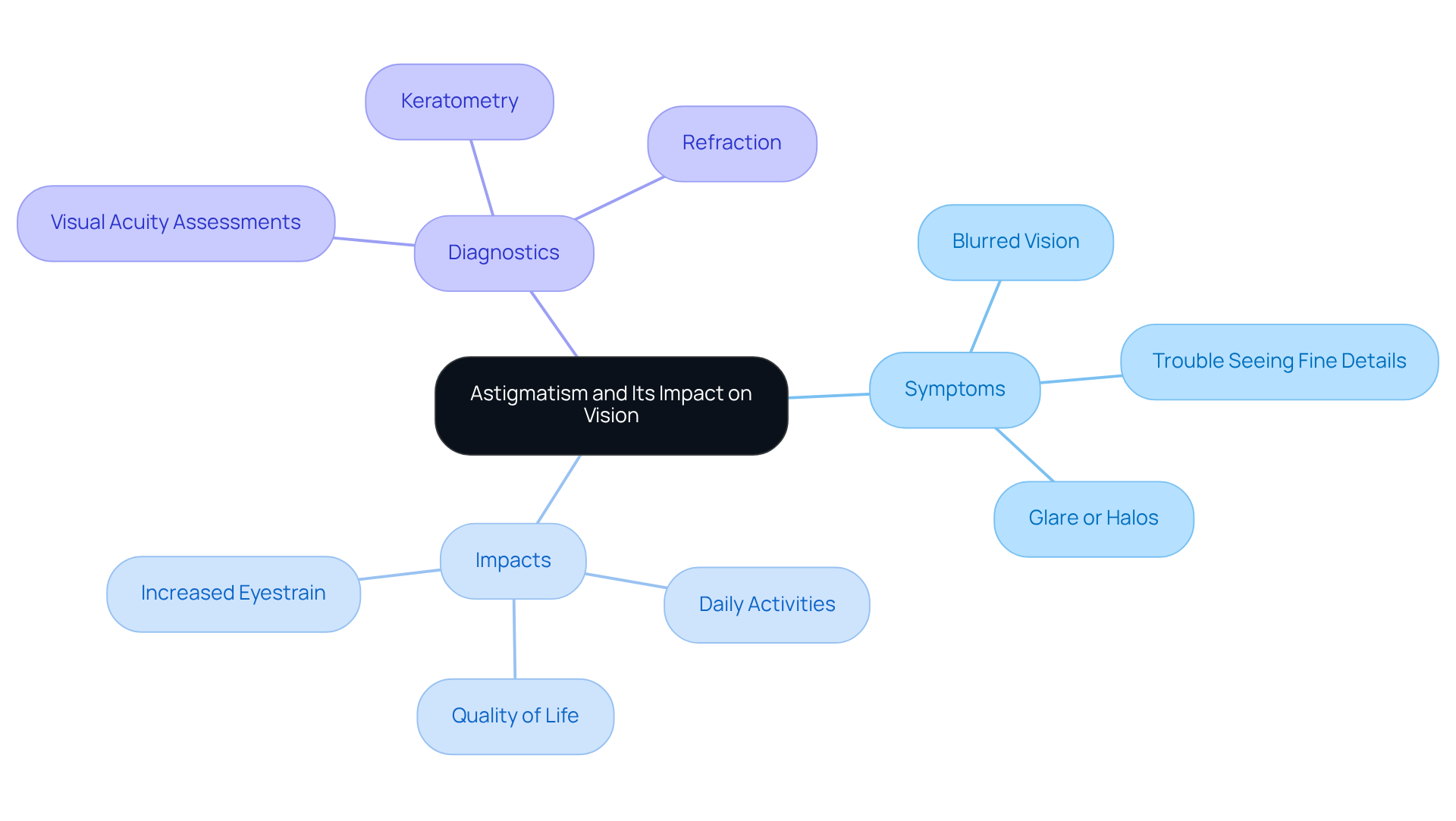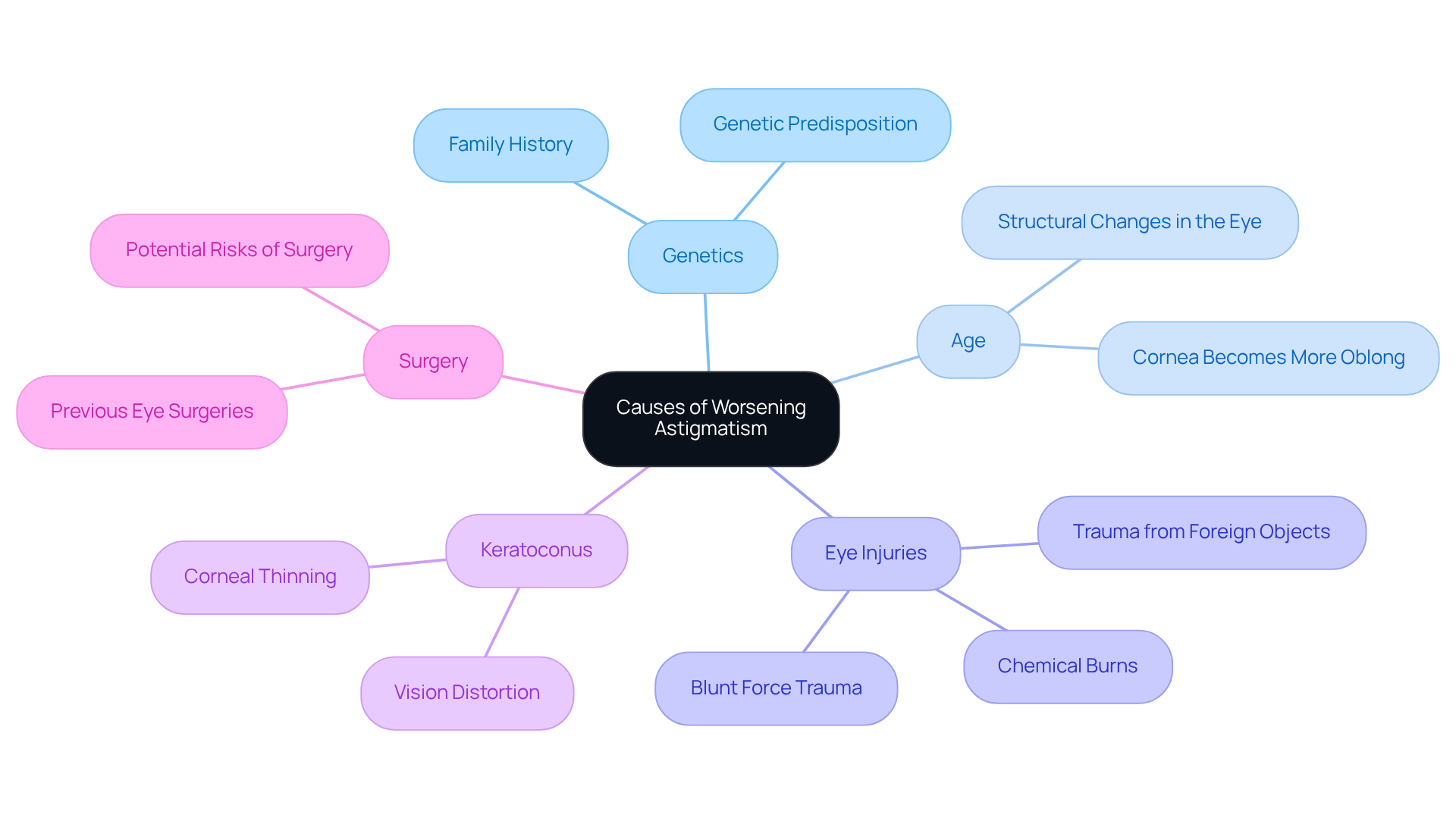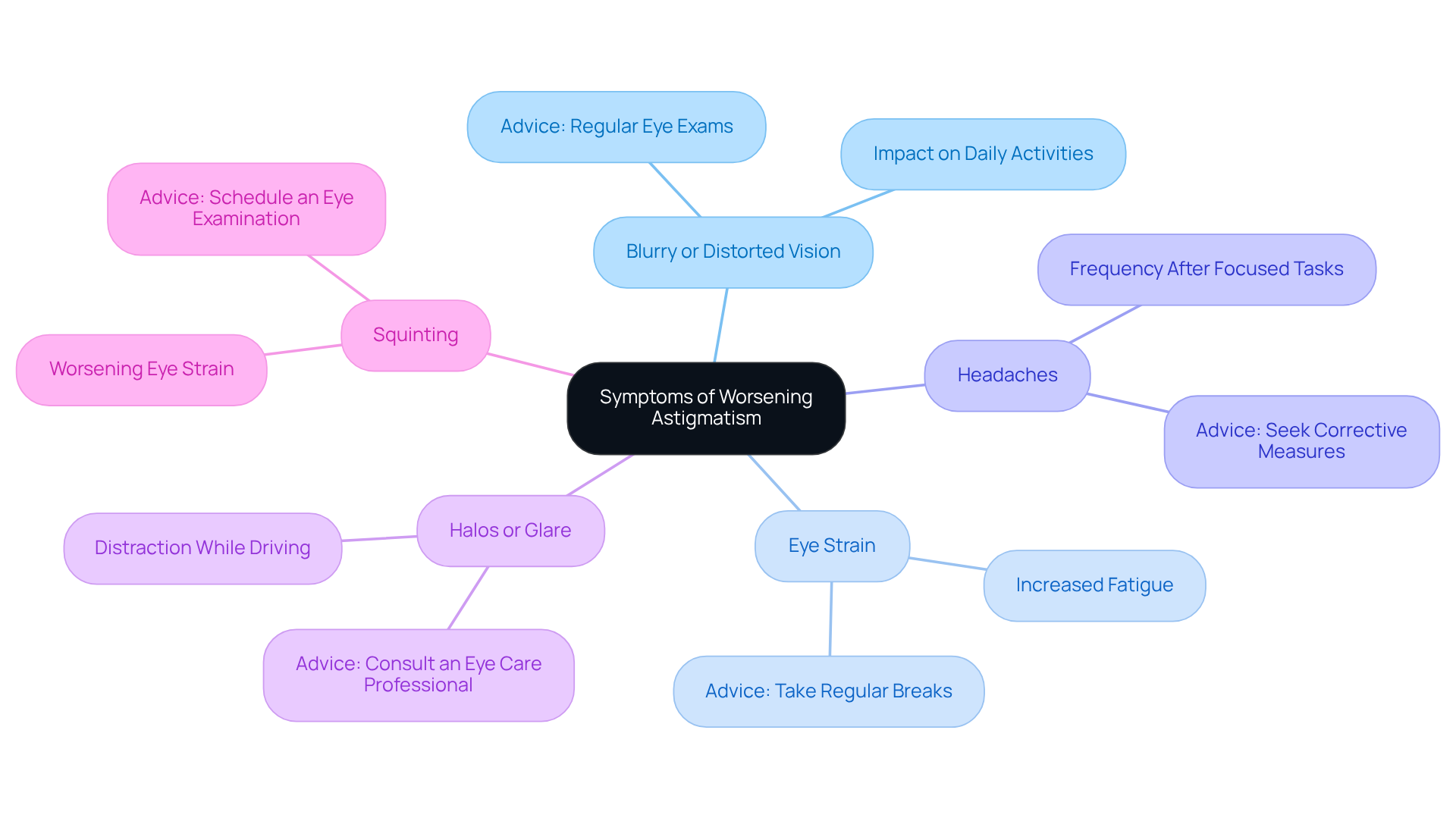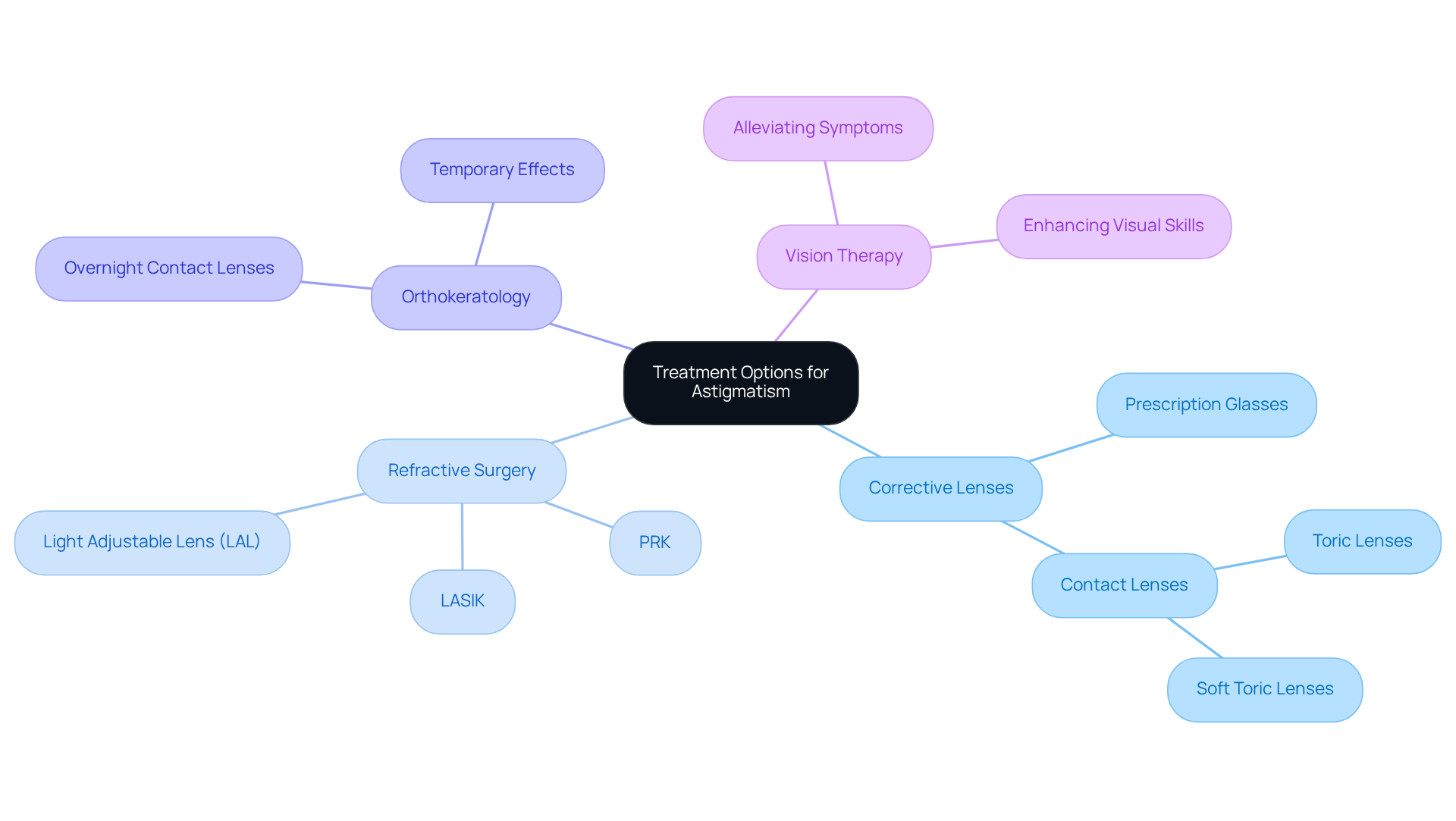Posted by: Northwest Eye in Astigmatism on November 9, 2025
Overview
Astigmatism can be a source of concern for many, and it’s important to understand that it can worsen due to several factors. The following can all play a role:
- Genetics
- Age-related changes in the cornea
- Eye injuries
- Keratoconus
- Previous eye surgeries
We understand that learning about these risks can feel overwhelming, but early detection and regular eye examinations are key to managing them effectively.
There are various treatment options available that can help improve your vision and enhance your quality of life. It’s common to feel uncertain about what steps to take next, but rest assured, you’re not alone in this journey. Many patients have found comfort in exploring their options and receiving the right care.
We are here to help you through this process. By prioritizing your eye health and seeking regular check-ups, you can take proactive steps towards better vision. Remember, your well-being is our top priority, and we’re committed to supporting you every step of the way.
Introduction
Astigmatism is a common refractive error that can really disrupt your daily activities. It often leads to blurred or distorted vision, glare, and those pesky halos around lights. We understand that dealing with these symptoms can be frustrating and concerning. It’s important to recognize that this condition can worsen over time, influenced by factors like genetics, age, and even eye injuries.
So, what can you do to manage your astigmatism effectively and prevent it from getting worse? This article will explore the causes, symptoms, and treatment options available to you. Our goal is to empower you to take charge of your vision and enhance your quality of life. Remember, you’re not alone in this journey, and we’re here to help you through it.
Define Astigmatism and Its Impact on Vision
Astigmatism is a common refractive error that many people experience. It occurs when the cornea or lens has an irregular curvature, making it difficult for the eye to focus light evenly on the retina. We understand that this condition can lead to various visual disturbances, such as:
- Blurred or distorted vision
- Trouble seeing fine details
- Glare or halos around lights
Halos are those bright rings that can surround a light source, while glare can disrupt your sight, especially when driving at night.
These symptoms can significantly affect your daily life, making activities like reading, driving, and using digital devices challenging. It’s common to feel frustrated when your vision isn’t clear, and this can impact your overall quality of life. Statistics show that astigmatism is one of the leading reasons people visit eye care specialists, highlighting how widespread this issue is.
Real-world experiences reveal that individuals with refractive errors often struggle with tasks that require clear sight, leading to increased eyestrain and discomfort. If left unmanaged, symptoms can escalate to include headaches and raise the question of whether can astigmatism get worse, leading to further sight disturbances. This raises the question of how can astigmatism get worse, making early detection and proper management crucial.
Additionally, blurred vision can also stem from other conditions like cataracts or diabetic retinopathy, which may complicate the symptoms you experience. Diagnostic techniques such as:
- Visual acuity assessments
- Keratometry
- Refraction
are essential for identifying refractive errors. We encourage you to schedule regular eye check-ups and consider corrective measures to minimize the impact of these symptoms.
If you’re experiencing issues like blurred vision, halos, or glare, please consult with a professional eye care provider. We are here to help you address these concerns effectively.

Identify Causes of Worsening Astigmatism
We understand that many people are concerned about whether astigmatism can get worse due to several interrelated factors. Here are some key causes to be aware of:
-
Genetics: If you have a family history of astigmatism or other refractive errors, it significantly increases your chances of developing or worsening the condition. Research shows that genetic predisposition plays a crucial role in the advancement of vision disorders. It’s essential to monitor your eye health closely if this applies to you.
-
Age: As we age, structural changes in the eye, particularly in the cornea, can lead to increased vision distortion. Over time, the cornea may become more oblong, raising the concern of whether astigmatism can get worse and worsening existing refractive errors. Astigmatism affects about 1 in 3 people, so it is important to understand how much astigmatism can get worse over time.
-
Eye Injuries: Trauma to the eye, whether from foreign objects, chemical burns, or blunt force, can change its shape and lead to concerns about whether astigmatism can get worse. If you experience an eye injury, it’s vital to consult an optometrist immediately to assess any damage and prevent further complications.
-
Keratoconus: This progressive condition causes the cornea to thin and bulge, significantly affecting vision. Timely identification and treatment are essential for reducing the progression of keratoconus and its impact on your sight.
-
Surgery: Previous eye surgeries, like cataract procedures, can sometimes alter corneal shape, leading to concerns about whether astigmatism can get worse, which can worsen vision distortion. It’s important to discuss potential risks with your eye care provider before undergoing any surgical procedures.
Identifying these causes is crucial for knowing when to seek expert guidance. Blurred eyesight can indicate a deteriorating eye condition, and being proactive can help reduce further decline in your sight. Routine eye examinations are essential for identifying refractive errors and monitoring any changes. Unaddressed refractive issues can lead to serious conditions like amblyopia and vision loss. If you’re experiencing blurred vision or any other troubling symptoms, please don’t hesitate to seek professional medical assistance promptly. We are here to help you through this process.

Recognize Symptoms of Worsening Astigmatism
Symptoms indicating that astigmatism can get worse can significantly impact your daily life. Here are some signs to watch for:
- Blurry or Distorted Vision: You might find it hard to see clearly at any distance, especially when reading or using screens. This can really hinder your daily activities. Unlike myopia and hyperopia, astigmatism affects vision at all distances.
- Eye Strain: If you’re spending long hours on visual tasks, you may experience increased fatigue or discomfort in your eyes. It’s essential to take regular breaks. Eye strain is a common issue for those with vision irregularities, highlighting the need for proper management.
- Headaches: Frequent headaches, particularly after activities that require focused sight, are often reported by those with astigmatism. This can indicate a need for corrective measures, especially since these headaches can worsen from the strain of trying to see clearly.
- Halos or Glare: Many people notice halos around lights, especially at night. This can be distracting and even dangerous when driving. Halos are bright rings surrounding a light source, while glare can disrupt your sight, particularly during the day. Both symptoms should be taken seriously and not ignored.
- Squinting: If you find yourself squinting to see more clearly, it can worsen eye strain and signal the need for an eye examination.
It is crucial to identify these symptoms promptly, as it raises the question of how much can astigmatism get worse. Timely interventions can help prevent further decline in your sight. As Wayne Chirisa wisely states, “Clear insight is not just a gift, it’s a responsibility to protect through conscious care.” With vision disorders affecting over 70% of school-age children, being aware of these signs is vital for maintaining optimal eye health.
Routine eye examinations are essential for managing vision issues and ensuring that any changes in your sight are addressed swiftly. We are here to help you through this process.

Explore Treatment Options for Astigmatism
Explore Treatment Options for Astigmatism
We understand that dealing with astigmatism can be challenging, but there are several treatment options available that can help improve your vision and quality of life. Here’s a look at some of the most common approaches tailored to individual needs:
-
Corrective Lenses: Prescription glasses and contact lenses, especially toric lenses, are often the first line of defense. These lenses are specifically designed to correct the uneven curvature of the cornea, enhancing visual clarity. Dr. Catherine Ong notes, “If your doctor has prescribed a glasses prescription with a number under the ‘cylinder’ or ‘cyl’ category, you have astigmatism.”
-
Refractive Surgery: Procedures like LASIK and PRK can reshape the cornea to improve sight. Many patients report significant improvements in their visual acuity after these surgeries. For cataract patients, the Light Adjustable Lens (LAL) offers a remarkable option, allowing for post-operative adjustments to refine sight outcomes. This procedure includes a pre-surgery consultation to assess your needs, followed by the surgical implantation of the lens, and careful post-operative care to ensure the best results.
-
Orthokeratology: This innovative, non-surgical method involves wearing specially designed contact lenses overnight to temporarily reshape the cornea. This allows individuals to enjoy clear sight during the day without needing glasses or contact lenses. It’s a convenient choice for those who prefer not to use corrective eyewear. However, keep in mind that the effects are temporary, so a consultation with an eye care professional is essential to determine if this option is right for you.
-
Vision Therapy: Particularly beneficial for children, vision therapy can enhance sight skills and alleviate symptoms related to refractive errors. This therapeutic approach focuses on improving the brain’s ability to process visual information, which is crucial for overall visual development.
Each treatment option comes with its own unique benefits and considerations. We encourage you to consult with your eye care provider to find the most suitable approach based on your specific circumstances and lifestyle. Remember, regular eye exams are vital for early detection and management, especially to understand if can astigmatism get worse. Untreated conditions can lead to complications such as amblyopia and decreased quality of life, so taking action is important.

Conclusion
Astigmatism is a common refractive error that can truly affect your vision and overall quality of life. We understand how important it is to grasp its potential to worsen, as this knowledge is key to managing your eye health effectively. By recognizing the symptoms, causes, and treatment options, you can take meaningful steps to address this condition.
Several factors can contribute to worsening astigmatism, including:
- Genetic predispositions
- Age-related changes
- Eye injuries
- Specific conditions like keratoconus
Symptoms such as:
- Blurred vision
- Eye strain
- Headaches
are important indicators that shouldn’t be ignored. Thankfully, there are various treatment options available, from corrective lenses to refractive surgery, that can help improve your vision and alleviate discomfort.
Ultimately, being aware and seeking timely intervention are essential in managing astigmatism. Regular eye examinations and consultations with eye care professionals are vital in spotting changes and implementing the right treatments. Taking these steps not only enhances your visual clarity but also protects against potential complications, ensuring a better quality of life. Remember, we are here to help you through this process.
Frequently Asked Questions
What is astigmatism?
Astigmatism is a common refractive error that occurs when the cornea or lens has an irregular curvature, making it difficult for the eye to focus light evenly on the retina.
What are the symptoms of astigmatism?
Symptoms of astigmatism include blurred or distorted vision, trouble seeing fine details, and glare or halos around lights.
How can astigmatism affect daily life?
Astigmatism can significantly impact daily activities such as reading, driving, and using digital devices, leading to frustration and a decreased quality of life.
What can happen if astigmatism is left unmanaged?
If left unmanaged, symptoms of astigmatism can escalate to include headaches and increased eyestrain, potentially worsening sight disturbances.
Can astigmatism get worse over time?
Yes, astigmatism can worsen, which makes early detection and proper management important.
What other conditions can cause blurred vision?
Blurred vision can also be caused by other conditions such as cataracts or diabetic retinopathy, which may complicate the symptoms of astigmatism.
What diagnostic techniques are used to identify astigmatism?
Diagnostic techniques for identifying astigmatism include visual acuity assessments, keratometry, and refraction.
What should I do if I experience symptoms of astigmatism?
If you experience symptoms like blurred vision, halos, or glare, it is advisable to consult with a professional eye care provider for effective management.






